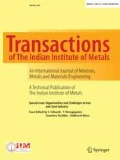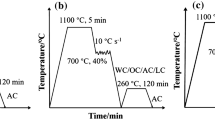Abstract
Surface mechano-chemical carburizing treatment (SMCT) is a modified version of surface mechanical attrition treatment and it is one of the cutting-edge technologies for producing hard nano-crystalline surface in metallic materials. In the present study, a case carburized surface layer is achieved in 1.75 Ni–Cr–Mo steel at room temperature using SMCT. Activated charcoal powder is continuously fed during the process so as to achieve the carbon diffusion into the surface layer. The SMCT process has been carried out for different periods say 15, 30, 45 and 60 min respectively. The microstructure and surface chemical composition is investigated by using TEM and XRF analysis. The mechanical properties such as yield strength (YS), ultimate tensile strength (UTS), fracture toughness and surface hardness of SMCT samples have been investigated using universal testing machine, Plain strain fracture toughness test and Microvickers hardness test respectively. The surface carbon content has been found to increase linearly and grain size reduces continuously with processing time. A 60 min SMCT samples reveal 0.8% C and about 10 nm grains over the surface. The SMCT samples show significant improvement in mechanical properties. The surface hardness increases from 180 HV0.1 to ~ 878 HV0.1 by 60 min of treatment. About 55% increment in the YS and 30% increment in UTS is achieved by 60 min of SMCT. It is also interesting to note that the fracture toughness of the samples enhances from 24 to 47 MPa \( \sqrt m \) after 60 min of SMCT.





Similar content being viewed by others
References
Benjamin J S, Metal Mater Trans 1(1970) 2943.
Suranaryana C, Prog Mater Sci 46 (2001) 1.
Schaffer G B, and Mccormick P G, Metal Mater Trans 21(1990)2789.
Jangg G, Kuttner F, and Korb G, Aluminium 51 (1975) 64.
Radlinski A P, and Calka A, Mater Sci Eng 134 (1991) 1376.
Calka A, Nikolov J J, and Williams J S, Mater Sci Forum 225–227 (1996) 527.
El-Eskandarany M S, Metall Mater Trans 27 (1996) 2374.
Tanaka T, Nasu S, Ishihara K N, Shingu P H, and Less J, Common Met 237 (1991) 237.
Matteazzi P, Basset D, Miani F, and Lecaer G, Nanostruct Mater 2 (1993) 217.
Tokumitsu K, Mater Sci Forum 235–238 (1997) 127.
Basset D, Matteazzi P, and Miani F, Mater Sci Eng 168 (1993) 149.
Tao N R, Wang Z B, Tong W P, Sui M L, Lu J, and Lu K, Acta Mater 50 (2002) 4603.
Lu K, and Lu J J, Mater Sci Technol 15 (1999) 193.
Zhang H W, Hei Z K, Liu G, Lu J, and Lu K, Acta Mater 51 (2003) 1871.
Guo S, Wang Z B, Wang L M, and Lu K, Surf Coat Technol 258 (2014) 329.
Liu W, Zhang C, Yanga Z, and Xia Z, Appl Surf Sci 292 (2014) 556.
Révész A, and Takacs L, J Alloys Compd 441 (2007) 111.
Umemoto M, Todaka Y, and Tsuchiya K, Mater Trans 44 (2003) 1488.
Huang L, Lu J, and Troyon M, Surf Coat Technol 201 (2006) 208.
Parrish G, Int Novelty 86 (1999) 343.
Hosford W F, Mechanical Behavior of Materials, Cambridge University Press, New York (2005) p 194.
American Society for Testing and Materials, Standard Test Method for Plane-Strain Fracture Toughness of Metallic Materials, E 399–90, ASTM International (2003).
Meyers M A, Mishra A, and Benson D J, Prog Mater Sci 51 (2006) 427.
Liu Y, Zhoua Y, Shen T, and Hui D, J Mater Res 26 (2011) 1734.
James C M, and Li (ed.), Mechanical Properties of Nanocrystalline Materials, Pan Stanford, Florida, (2011) p 245.
Ritchiet R O, Francis B, and Server W L, Metal Mater Trans 7 (1976) 831.
Author information
Authors and Affiliations
Corresponding author
Rights and permissions
About this article
Cite this article
Sahu, J.N., Sasikumar, C. Mechanical Properties of a Ni–Cr–Mo Steel Subjected to Room Temperature Carburizing Using Surface Mechano-Chemical Carburizing Treatment (SMCT). Trans Indian Inst Met 71, 915–921 (2018). https://doi.org/10.1007/s12666-017-1223-6
Received:
Accepted:
Published:
Issue Date:
DOI: https://doi.org/10.1007/s12666-017-1223-6




